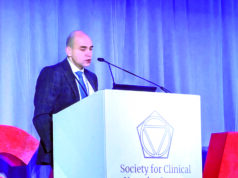A US-based multicentre study has found that while chronic venous insufficiency is “primarily observed in white women”, there are other notable differences in the incidence and prevalence of disease severity and outcomes when comparing patients’ racial groups, with African Americans requiring a higher number of superficial vein treatments to achieve good results. Peter J Pappas (Center for Vein Restoration, Greenbelt, USA) presented the findings at the European Venous Forum (EVF; 27–29 June) in Zurich, Switzerland.
“Interestingly, if you look at the prevalence of disease by age and by race, most of the studies that have been presented have indicated that with progressive deciles, as you increase in age, the prevalence also increases”, explained Pappas. However, his group found that for some racial groups, prevalence was seen to decrease with age instead. This was observed in African American and Hispanic patients. “To my knowledge,” said Pappas, “this is the first time that the incidence of disease is reported to decrease based upon duration of presentation.” Furthermore, while African American patients needed a higher number of superficial vein treatments and interventions in order to attain the same results as other patient groups, Pappas et al also found that African American patients had the lowest recommendation rates for ablation, ultrasound-guided foam sclerotherapy and phlebectomy. To explain the low recommendation rates, Pappas pointed to the observation that one third of African American patients presented with C0 disease, which “may be secondary to higher BMIs and an increased incidence of osteoarthritis in this group”.
Pappas also highlighted cultural reasons for certain findings, including the higher rate of C1 disease presented in Hispanic patients, as this group is more likely to seek treatment for spider veins and C1 disease.
The retrospective chart review of prospectively collected data analysed a cohort of 66.621 patients with chronic venous insufficiency across 78 centres in the USA. Patients were divided into five racial groups, including African American, Asian, Hispanic, White, and Other (race not recorded). Each group was further stratified by CEAP class for sub-group analysis. Average patient age was 56.8±14.7, with 77% being female and 23% male. Of the total cohort, 17% were African American, 3% were Asian, 18% Hispanic, 55% White and 8% Other.
While incidence of disease was seen to decrease over the time period 2015–2017 for African Americans (20% vs. 15% incidence) as well as Asians (4% vs. 2% incidence), the same remained stable in the Hispanic group over time (18%) and increased for the Other and White categories (7% vs. 9% and 52% vs. 56%, respectively). Regarding prevalence, Pappas noted it was “similar between African Americans and Hispanics—the lowest group that presented with venous disease was Asians, and as expected, the highest prevalence was found for people who self-identified as White”. Furthermore, the “vast majority” of disease was seen in women across all patient race groups, with the exception of Hispanic patients who were more often male with a 5:1 ratio.
Pappas’ group had previously published outcomes data in Medicare and non-Medicare beneficiaries, and demonstrated differences in presentation and number of procedures needed in patients older than 65 years of age, as opposed to younger patients. Furthermore, Pappas explained, “we determined that progressive increases in BMI are associated with worse outcomes after endothermal ablations, phlebectomies and ultrasound-guided foam sclerotherapy”. Their past publications and results led Pappas et al to launch an investigation into potential differences in presentation and treatment outcomes of chronic venous insufficiency, based upon patient ethnicity.








